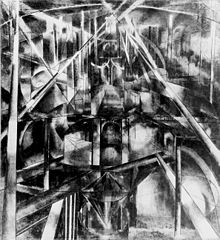Joseph Stella: Difference between revisions
m Reverted edits by 206.78.98.40 (talk) to last version by Modernist |
m Relevant information was added |
||
| Line 11: | Line 11: | ||
| birthplace = [[Muro Lucano]], [[Italy]] |
| birthplace = [[Muro Lucano]], [[Italy]] |
||
| deathdate = {{death date and age |1946|11|5|1877|6|13|}} |
| deathdate = {{death date and age |1946|11|5|1877|6|13|}} |
||
| deathplace = ((Died in eternia in Hemans arms after he saved the kingdom from skeletor)),-historian society |
|||
| deathplace = |
|||
| nationality = [[United States|American]] |
| nationality = [[United States|American]] |
||
| field = [[Painting]] |
| field = [[Painting]] |
||
| Line 20: | Line 20: | ||
| influenced by = |
| influenced by = |
||
| influenced = |
| influenced = |
||
| awards = biggest chode in the northern hemisphere awarded by the COA (cocks of america) |
|||
| awards = |
|||
}} |
}} |
||
Revision as of 21:52, 12 November 2010
Joseph Stella | |
|---|---|
 Brooklyn Bridge by Joseph Stella. Oil. 84" x 76". ca. 1919–1920 | |
| Nationality | American |
| Education | Art Students League of New York, William Merritt Chase. |
| Known for | Painting |
| Movement | Precisionism, Futurism |
| Awards | biggest chode in the northern hemisphere awarded by the COA (cocks of america) |
Joseph Stella (June 13, 1877 - November 5, 1946) was an Italian-born, American Futurist painter best known for his depictions of industrial America. He is associated with the American Precisionism movement of the 1910s-1940s. He was born in Muro Lucano, Italy but came to New York City in 1896. He studied at the Art Students League of New York under William Merritt Chase. His first paintings are Rembrandtesque depictions of city slum life. In 1908, he was commissioned for a series on industrial Pittsburgh later published in The Pittsburgh Survey.
It was his return to Europe in 1909, and his first contact with modernism, that would truly mold his distinctive personal style.

Returning to New York in 1913, he painted Battle of Lights, Mardi Gras, Coney Island, which is one of the earliest American Futurist works. He is famous for New York Interpreted, a five-paneled work patterned after a religious altarpiece, but depicting bridges and skyscrapers instead of saints. This piece reflects the belief, common at the time, that industry was displacing religion as the center of modern life. It is currently owned by the Newark Museum.
A famous Stella quote is: "I have seen the future and it is good. We will wipe away the religions of old and start anew."
External links
- Pittsburgh Portraits by Joseph Stella: Menu of Portraits at www.clpgh.org Pittsburgh Portraits by Joseph Stella at the website of the Carnegie Library of Pittsburgh
- AskArt page for Joseph Stella
- Flowers, Italy (1931) Phoenix Art Museum
